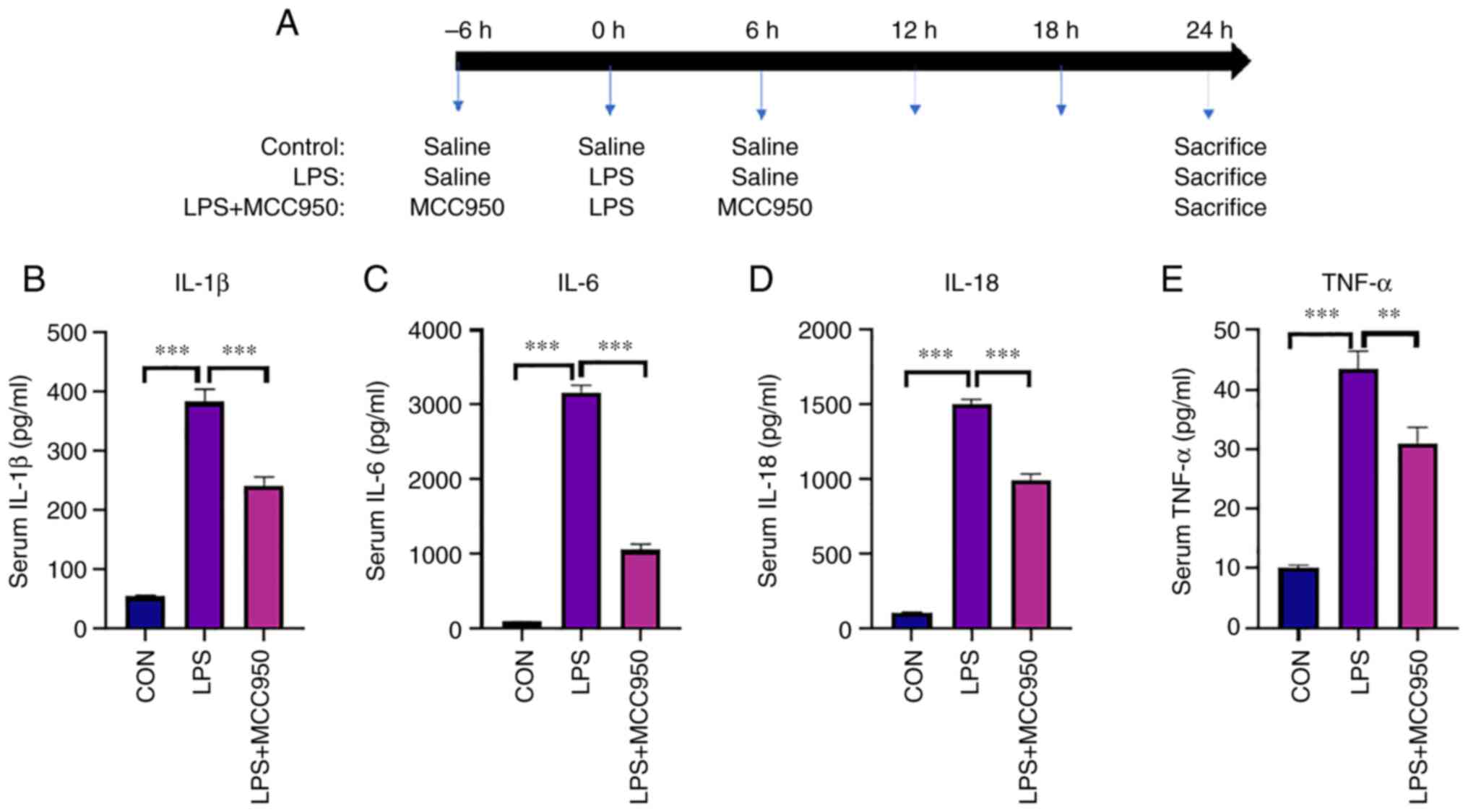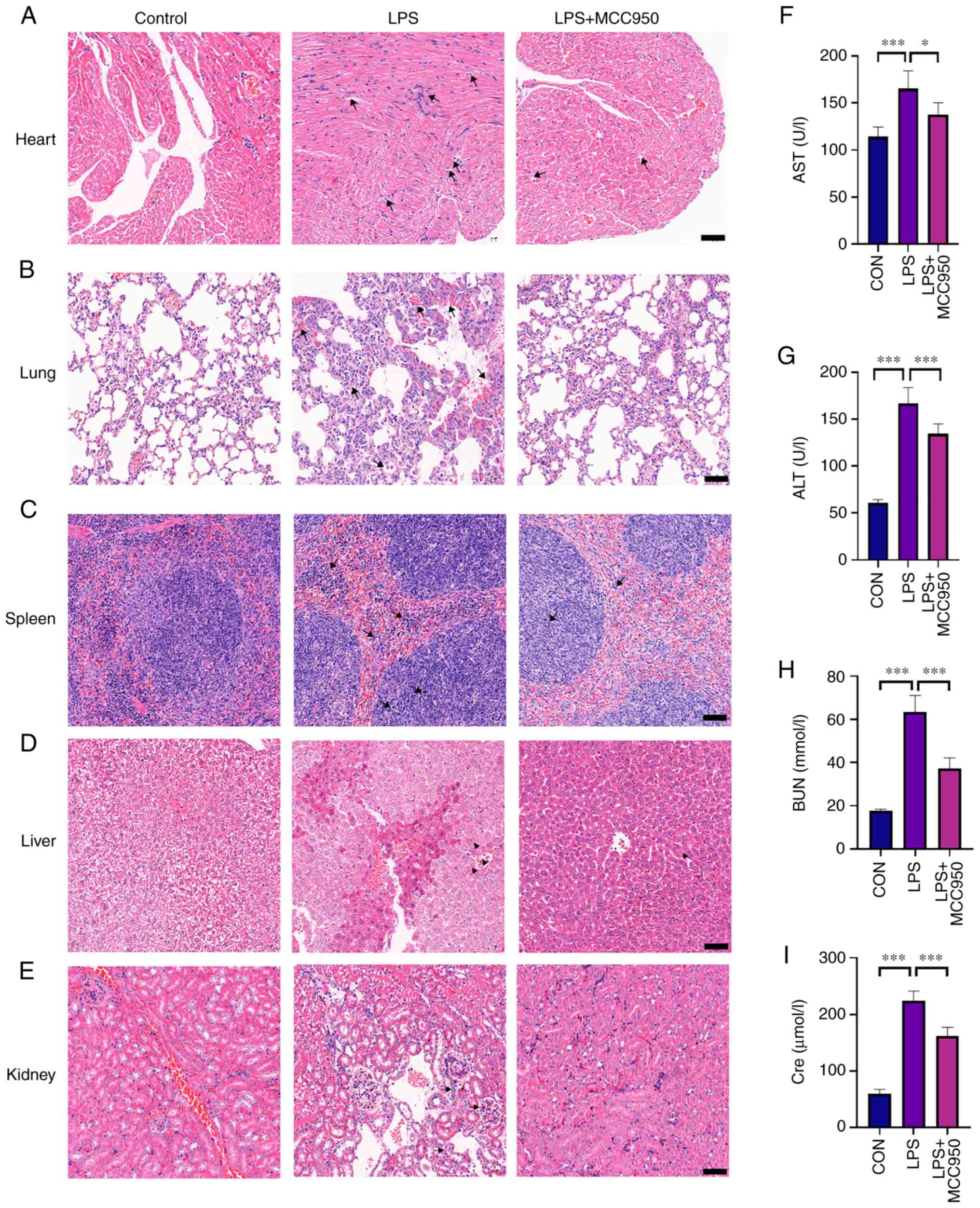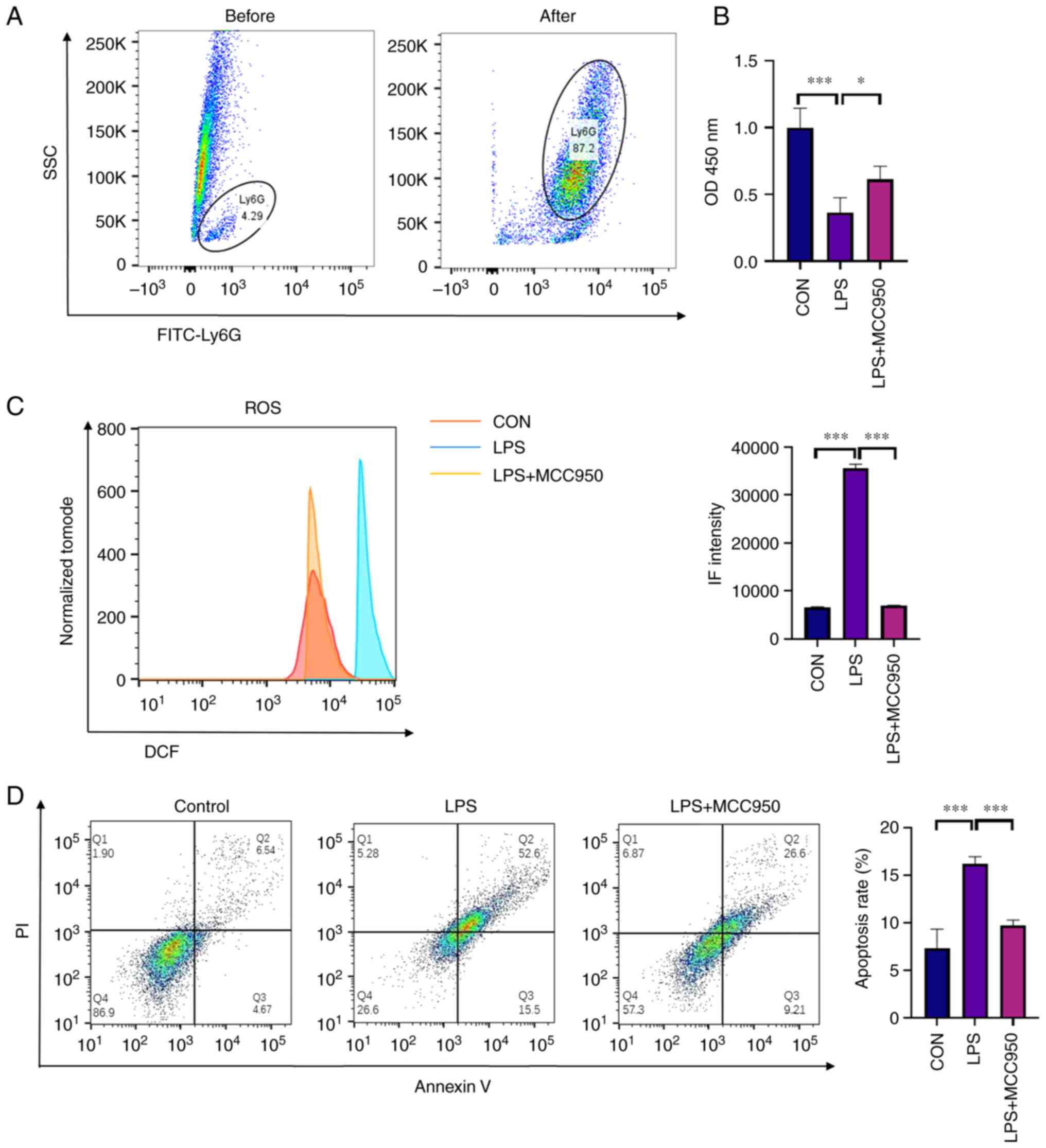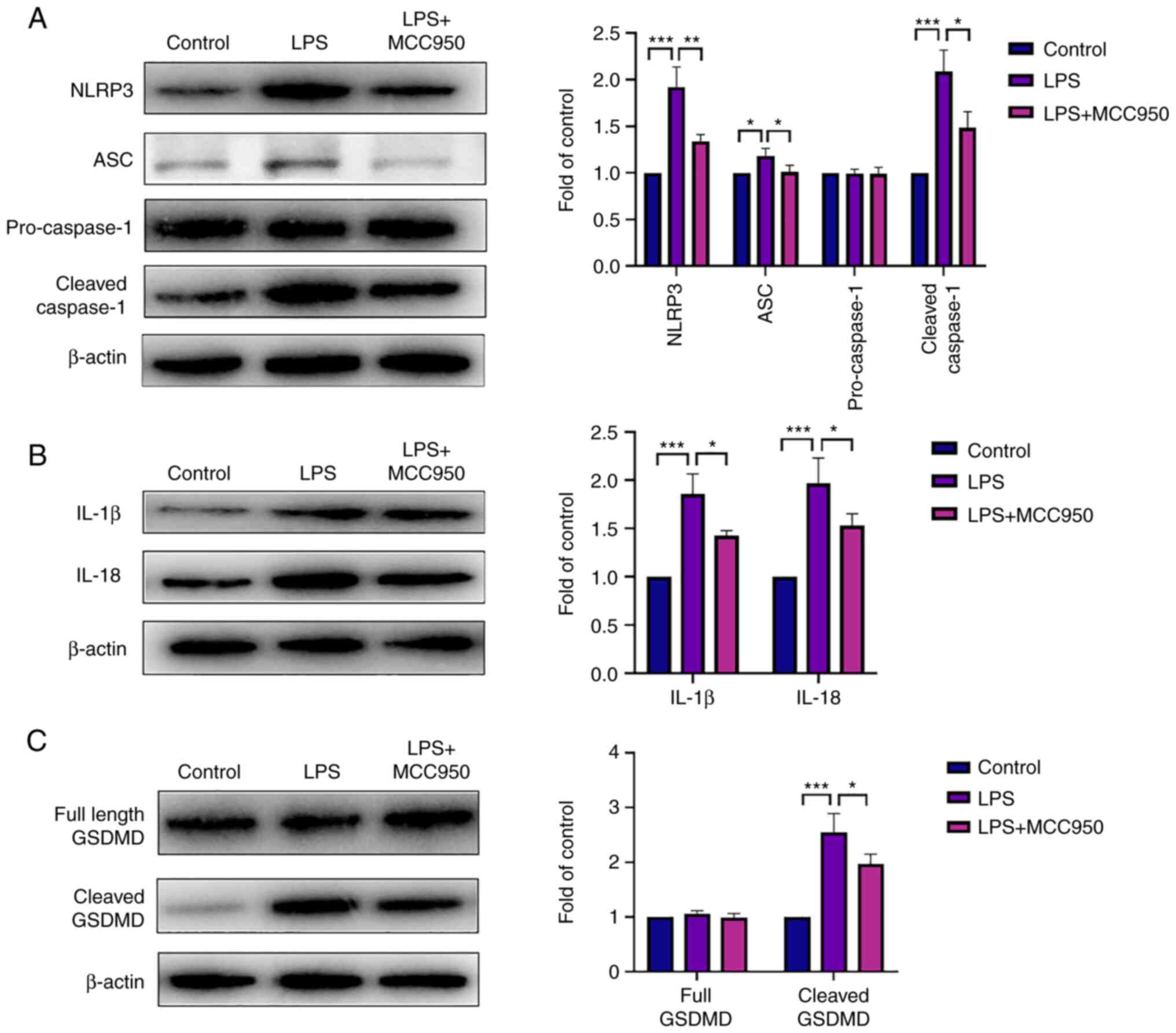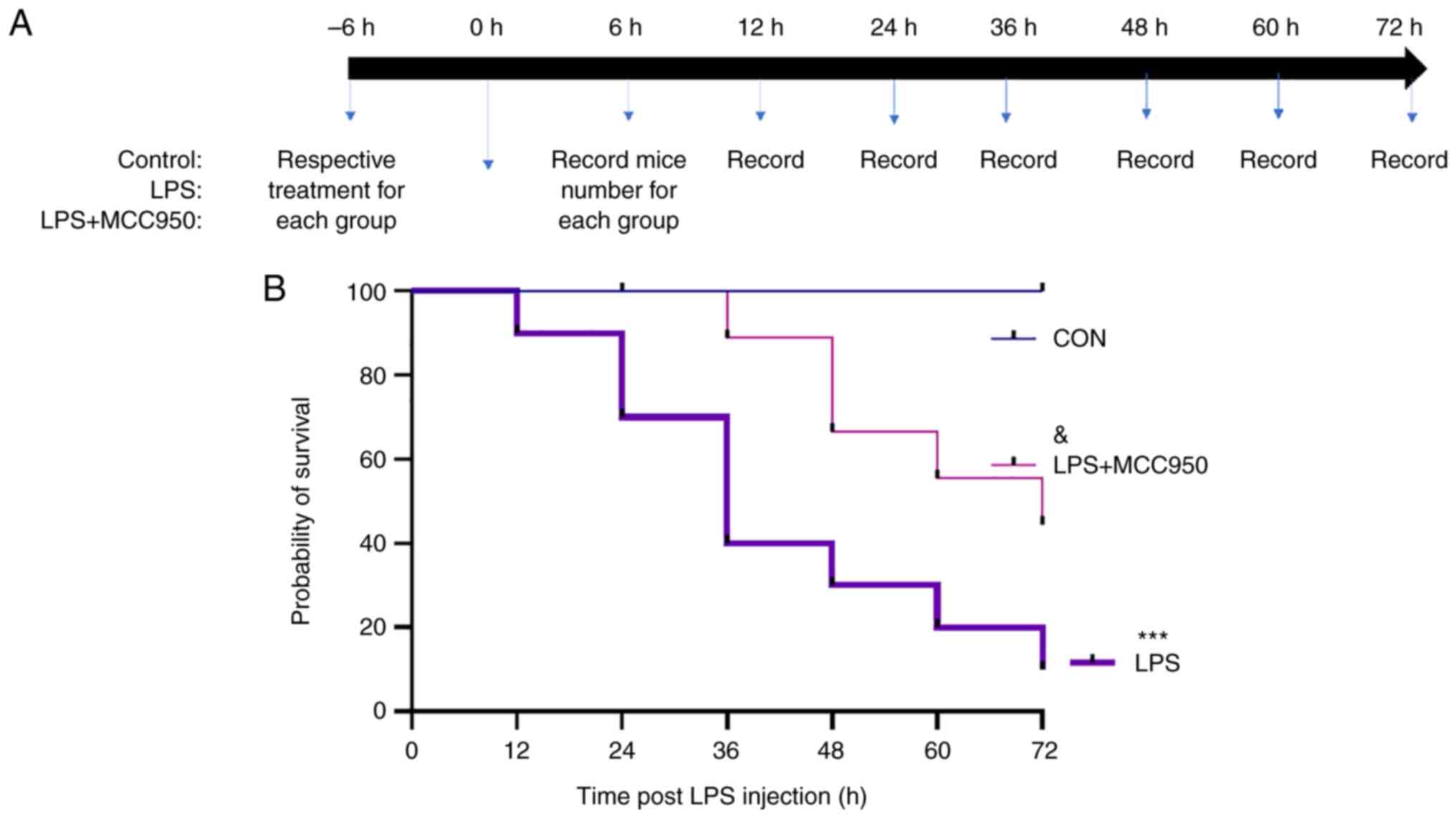MCC950 improves lipopolysaccharide‑induced systemic inflammation in mice by relieving pyroptosis in blood neutrophils
- Authors:
- Published online on: July 13, 2023 https://doi.org/10.3892/etm.2023.12117
- Article Number: 417
Abstract
Introduction
Sepsis is an infection-induced systemic inflammatory response syndrome accompanied by multiple organ injury and failure (1). Timely treatment is critical for sepsis; otherwise, it can develop into severe systemic inflammation and eventually result in multiple organ injury and dysfunction (2). A previous extensive study revealed that activation of NOD-like receptors, particularly the NLR family pyrin domain containing 3 (NLRP3) inflammasome, plays an important role in lipopolysaccharide-induced systemic inflammation. Additionally, activation of the NLRP3 inflammasome and its downstream inflammatory factors, including interleukin (IL)-1β and IL-18, is involved in caspase-dependent pyroptosis (3). Pyroptosis is a type of programmed cell death that is associated with inflammation. It is morphologically characterised by apoptosis and necrosis and has also been identified as a major cause of sepsis-induced tissue damage in previous research (4). Therefore, appropriate suppression of pyroptosis-related proteins may be a possible therapeutic strategy for sepsis and sepsis-induced organ injury.
Neutrophils, which are the most abundant cells in the immune system, are responsible for maintaining the equilibrium of the body through repeated programmed cell death. Neutrophils arrive at the site of infection and release a considerable number of inflammatory cytokines and reactive oxygen species (ROS) during sepsis, which exacerbates the inflammatory response (5). With the development of sepsis, multiple organs, such as the heart, lung, kidney and spleen, are infiltrated with a large number of activated neutrophils that secrete a variety of enzymes and inflammatory mediators that are partly dependent on pyroptosis in neutrophils and further accelerate organ injury (6). Hence, the regulation of pyroptosis in neutrophils may play an important role in sepsis treatment.
The NLRP3 inflammasome is a multiprotein complex that responds to a wide range of danger signals from different sources, including microorganisms (7). Caspase-1 self-shearing and activation are aided by the formation of the NLRP3 inflammasome. The maturation of proinflammatory cytokines such as IL-1β and IL-18 is reduced by activated caspase-1(8). Furthermore, activated caspase-1 is associated with cleaved gasdermin D (GSDMD). The cleaved N-terminal domain of GSDMD translocates to the cell membrane and forms pores, which facilitate the release of inflammatory cytokines and trigger the classical signals of pyroptosis in the circulating blood (9,10). Previous studies have reported that the inhibition or activation of NLRP3 assembly or activation effectively improves sepsis (11,12). In the present study, the effect of MCC950 on relieving LPS-induced inflammation was investigated, and it was also determined whether the effect of MCC950 was mediated by inhibiting pyroptosis in neutrophils.
Materials and methods
Animals
A total of 60 male C57BL/6J mice (8-10 weeks old; weight, 25-30 g) were purchased from the Beijing Weitong Lihua Animal Technology Co., Ltd. and fed in a specific-pathogen-free environment with a controlled temperature (22˚C) and relative humidity of 40-70%. The physiological characteristics of female mice are affected by periodic endocrine changes, such as estrus cycle, pregnancy and delivery, which may cause significant variations in their physiological indicators, and thus were not selected for the present study. Food and water were available ad libitum, and a 12-h light/dark cycle was maintained. All experiments were approved by the Ethics Committee of Yangzhou University (Yangzhou, China) (approval no. 202201001). All authors have read the ARRIVE guidelines, and the study was performed according to the ARRIVE guidelines. All mice were anaesthetised with 2% and sacrificed with 5% isoflurane.
Mouse model of systemic inflammation
The septic mouse model was established by administering 10 mg/kg LPS (O55:B5; Sigma-Aldrich; Merck KGaA) by intraperitoneal (i.p.) injection. The mice were randomised into the following three groups: i) In the control group (CON), the mice received a volume of sterile saline equal to the volume of LPS; ii) in the LPS-induced inflammatory group (LPS), the mice received 10 mg/kg LPS via i.p. injection; and iii) in the MCC950 treatment group (LPS + MCC950), the mice were treated with 10 mg/kg MCC950 twice: 6 h pre- and post-LPS. The mice were sacrificed 24 h after LPS injection. Each group contained 10 mice.
Serum sample preparation
The mice were sacrificed via isoflurane, and blood samples were collected from an ocular vein. The serum was separated by centrifugation at 1,500 x g for 15 min (4˚C), and the upper layer of the serum was harvested and stored at -80˚C for further analysis. Blood urea nitrogen (BUN) (Elabscience Biotechnology, Inc.; cat. no. E-BC-K329-S) and creatinine (Cre) (Elabscience Biotechnology, Inc.; cat. no. E-BC-K188-M), which are biomarkers of kidney toxicity, as well as alanine transaminase (ALT) (Elabscience Biotechnology, Inc.; cat. no. E-BC-K235-S) and aspartate aminotransferase (AST) (Elabscience Biotechnology, Inc.; cat. no. E-BC-K236-M), which are indicators of liver function, were analysed using respective kits based on colorimetric principles according to the manufacturer's instructions.
Neutrophil isolation
According to the manufacturer's instructions, neutrophil isolation was performed using the MACS Neutrophil Isolation Kit (Miltenyi Biotec, Inc.; cat. no. 130-097-658). Briefly, 2 ml of buffer A was added to a bottle of MACSxpress whole blood cell isolation cocktail and gently pipetted. Buffer B was then mixed with the cocktail. Subsequently, 1 ml of isolation mix was merged with anticoagulated whole blood and incubated for 5 min at room temperature with gentle shaking. The tube was then placed in a magnetic grate for 15 min to separate the labelled cells. The supernatant was collected, and the residual erythrocytes were removed by erythrocyte lysis buffer (Wuhan Servicebio Technology Co., Ltd.; cat. no. G2015-500ML).
Flow cytometry
The neutrophils were collected and stained with Ly6G-FITC (Biolegend, Inc.; cat. no. 127605) to determine the isolation efficiency. Briefly, the isolated cells were suspended in diluted Ly6G-FITC staining solution at a concentration of 1 million/ml. After 30 min of incubation at 37˚C, the cells were washed with PBS supplemented with 0.5% FBS three times and detected by flow cytometry to define the purity and cell activity. The oxidative stress levels of isolated cells were analysed using an ROS assay kit (Beyotime Institute of Biotechnology; cat. no. S0033S) according to the manufacturer's instructions. To analyse cell necrosis, the isolated cells were stained with Annexin V/PI using the Annexin V/PI staining kit (Beyotime Institute of Biotechnology; cat. no. C1062S) and incubated for 10-20 min at room temperature in the dark. Data were collected on a multicolor flow cytometer (BD Fortessa; BD Biosciences) and analyzed with FlowJo software (version 10.8; FlowJo LLC).
Histopathology analysis
Lung, liver, kidney, spleen, and heart tissues were collected in 4% PFA (24 h at room temperature) and embedded in paraffin. The tissues were cut into 5-µm thick sections and stained with haematoxylin and eosin (H&E). The sections were observed and photographed using a light microscope (Olympus Corporation).
Enzyme-linked immunosorbent assay (ELISA)
According to the manufacturer's instructions, the concentrations of IL-1β, IL-6, IL-18, and TNF-α were determined using ELISA kits (Mlbio; Shanghai Enzyme-linked Biotechnology Co., Ltd.; cat. nos. ml098416, IC50325-1, ml002294 and mIC50536-1, respectively) The values were measured using a Tecan Spark plate reader (Tecan Group, Ltd.).
Assessment of survival rates
For survival analyses, 30 male mice were divided into three groups as aforementioned. The concentration of LPS was changed to 15 mg/kg. Following the injection of LPS, the number of mice that succumbed was recorded every 12 h for 72 h. The survival rates were analysed using ImageJ software (v1.8.0; National Institutes of Health). At the endpoint, all mice were euthanised with isoflurane (2% isoflurane was used to induce anesthesia and 5% was used for euthanasia, causing the mice to lose consciousness quickly). After confirming that the mice had no movement, were not breathing, and their pupils were dilated, the anesthesia machine was closed, and then the mice were observed for another 2 min to confirm cardiac arrest and death. If the mice lost >10% of their body weight or ate <50% of their normal amount in 24 h, or were unable to eat on their own, or were either excessively weak and/or had hypothermia, the mice were euthanised as these were considered as humane endpoints.
Western blotting
For western blotting, the isolated neutrophils were lysed in RIPA lysis buffer (Beyotime Institute of Biotechnology) supplemented with 1% protease and phosphatase inhibitor cocktail (MedChemExpress) on ice for 15 min and centrifuged at 12,000 x g for 15 min at 4˚C. The supernatants were collected for western blotting. The protein concentration was determined using a BCA kit (Beyotime Institute of Biotechnology). The proteins (15 µg/sample) in each sample were separated using precast gels (Beyotime Institute of Biotechnology) and then transferred to PVDF membranes (Merck KGaA). The membranes were blocked with 5% BSA buffer (Wuhan Servicebio Technology Co., Ltd.) for 1 h at room temperature and then incubated with primary antibodies targeting full-length GSDMD, cleaved GSDMD, IL-1β and IL-18 (all 1:1,000; ABclonal Biotech Co., Ltd.; cat. nos. A18281, A22523, A16288 and A16737, respectively), NLRP3, caspase-1 and cleaved caspase-1 (all 1:1,000; Cell Signaling Technology, Inc.; cat. nos. 15101, 24232S and 89332, respectively), apoptosis-associated speck-like protein containing CARD (ASC) (1:1,000; HUABIO; cat. no. ER6274) and β-actin (1:2,000; ABclonal Biotech Co., Ltd.; cat. no. AC006) After overnight incubation at 4˚C, the blots were washed with TBST (TBS buffer with 1% Tween-20) three times and then incubated with specific secondary antibodies (goat anti-rabbit IgG-HRP; 1:2,000; cat. no. HA1001; and goat anti-mouse IgG-HRP; 1:2,000; cat. no. HA1006; both HUABIO) for 2 h at room temperature. Finally, the bands were visualised using an enhanced chemiluminescence reagent (Bio-Rad Laboratories, Inc.). The greyscale intensities of the proteins were analysed using ImageJ software (v1.8.0; National Institutes of Health).
Statistical analysis
The results are presented as the means ± standard deviations. All experiments were performed independently at least three times. For mouse experiments, no specific blinding method was used, but the mice in each sample group were selected randomly. Statistical significance between groups was determined by one-way analysis of variance (ANOVA) and Tukey's post hoc test. The Kaplan-Meier method with log-rank test was used to analyze the survival probabilities of the mice. P<0.05 was considered to indicate a statistically significant difference. GraphPad Prism 8 software (Dotmatics) was used for analysis.
Results
MCC950 decreases the levels of inflammatory cytokines in an LPS-induced inflammation mouse model
The mice were randomly divided into three groups. The experimental process and the treatments are shown in Fig. 1A. A total of 24 h after LPS injection, the mice were sacrificed, and blood was collected from the inferior vena cava (~1.0 ml/mouse). The results revealed that LPS markedly induced an inflammatory response in mice, including the excessive secretion of inflammatory cytokines in the blood. Compared with the control group (CON), the levels of IL-1β, IL-6, IL-18 and TNF-α (Fig. 1B-E) in the blood were upregulated in the LPS group. In the MCC950 + LPS group, the levels of these cytokines were lower than those in the LPS group (Fig. 1B-E).
MCC950 alleviates LPS-induced multiple organ damage
Organs such as the heart, liver, spleen, lung and kidney were collected, embedded in paraffin, and stained with H&E after LPS injection and MCC950 therapy. Histological images revealed that LPS caused multiple organ damage.
As revealed in Fig. 2A, typical fibre bundles in the control group were neatly organised and free of oedema in the interstitial space. In addition to interstitial oedema, the fibre bundles in septic mouse cardiac tissues 24 h after LPS administration were organised loosely, fragmented and even disintegrated. In addition, some cardiomyocytes deteriorated and dissolved, while necrosis and moderate inflammatory cell infiltration were observed. Inflammatory cell infiltration and fibre bundles were normal after MCC950 treatment.
The histological images in Fig. 2B depict the lung damage that occurred during sepsis. The lung tissues were intact and clear, and the cells were neatly distributed without oedema or indications of harm in the control group. LPS injection significantly increased inflammatory cell infiltration, interstitial oedema, and phagocyte infiltration in the alveolar space. MCC950 decreased inflammatory cell infiltration and interstitial oedema.
As revealed in Fig. 2C, lymphoid tissue proliferation was not significant in the control group, and the red pulp was mainly composed of lymphocytes. In the sepsis group, lymphoid hyperplasia and apoptosis were observed in the white pulp of the spleen. In addition, acute and chronic inflammatory cell infiltration was observed in the red pulp of mice with sepsis. MCC950 administration alleviated LPS-induced inflammatory infiltration, lymphoid hyperplasia, and cell apoptosis.
As shown Fig. 2D, the liver lobules of mice in the control group were intact and clear, the cells were neatly distributed and free of oedema, and the liver stripes were regular and clear. In the LPS-treated group, the liver lobules were damaged, the liver cells were swollen with spot necrosis, and the intracellular space was increased. When LPS-treated mice were treated with MCC950, morphological analysis revealed that liver tissue damage was significantly decreased. In addition, LPS-treated mice exhibited a high level of neutrophil infiltration, whereas MCC950 treatment reduced neutrophil infiltration. ALT and AST levels, which are indicators of liver function, were also assessed. The results demonstrated that MCC950 reduced the levels of ALT and AST, which were increased by LPS (Fig. 1F and G).
As revealed in Fig. 2E, the kidney tissues were clear and intact, and the cells were arranged neatly without oedema or injury in the control group. LPS-treated mice exhibited deeply damaged kidney lobules, and the cells were swollen with increased intracellular spaces. In addition, neutrophil infiltration was observed in the kidney tissues in the LPS group. MCC950 treatment alleviated the damage to the kidney induced by LPS, as indicated by clearer nephrons, less vacuolization, and less infiltration. In addition, the concentrations of BUN and Cre, which are markers of kidney damage, were detected. The results showed that LPS increased Cre and BUN concentrations in serum, which were significantly decreased by MCC950 treatment (Fig. 1H and I).
MCC950 alleviates the damage to neutrophils in peripheral blood induced by sepsis
To explore the mechanism of MCC950 in the treatment of LPS-induced inflammation, further experiments were performed. Based on the morphological analysis of multiple organs by H&E staining, it is considered that neutrophils play an important role in sepsis. First, the purity of neutrophils (stained with Ly6G antibody) isolated from mouse blood was determined using flow cytometry. The results showed that neutrophils accounted for ~5% of the peripheral blood lymphocytes in mice before isolation. After isolation, the purity of neutrophils was detected by FACS analysis, and the purity of neutrophils was ~87% among the collected cells (Fig. 3A). In addition, the viability of the isolated neutrophils was analysed using the CCK-8 assay. The results indicated that LPS decreased the viability of neutrophils in peripheral blood, while MCC950 alleviated cell damage (Fig. 3B). The ROS levels in neutrophils isolated from each group of mice, were also assessed. The results revealed that LPS increased ROS levels in neutrophils, while MCC950 alleviated the oxidative stress induced by LPS (Fig. 3C). To determine the proportion of cells, Annexin V/PI staining was performed and FACS was used for detection. The results revealed that LPS injection promoted cell damage, including early-stage apoptosis (PI-negative and Annexin V-positive) and late-stage apoptosis (PI-positive and Annexin V-positive), while MCC950 alleviated the early and late stage of apoptosis. Thus, it was determined that MCC950 treatment alleviated damage in neutrophils (Fig. 3D).
MCC950 attenuates pyroptosis in neutrophils by inhibiting the ROS/NLRP3/caspase-1 pathway
In order to investigate the mechanism of MCC950 in LPS-induced neutrophil pyroptosis, proteins related to pyroptosis were analysed by western blotting. The NLRP3 protein level was increased in the LPS group, and MCC950 downregulated its expression. Consistent with the change in NLRP3 expression, the levels of cleaved caspase-1 and ASC were upregulated by LPS, while MCC950 decreased their expression (Fig. 4A). In addition, the inflammatory cytokines IL-1β and IL-18, which are downstream of NLRP3, were induced by LPS, and MCC950 reversed this trend (Fig. 4B). Cleaved GSDMD, a marker of pyroptosis, was enhanced during LPS-induced inflammation, and MCC950 treatment inhibited this process (Fig. 4C). Taken together, these data indicated that the NLRP3 inflammasome played a critical role in LPS-induced neutrophil pyroptosis and that MCC950 exerted a protective effect on the ROS/NLRP3/caspase-1 axis.
MCC950 improves the mortality of septic mice
Survival rate analysis was performed according to the schematic in Fig. 5A. The control group exhibited a 100% survival rate. Compared with mice in the LPS group, MCC950-treated mice exhibited significantly improved survival during sepsis (Fig. 5B).
Discussion
Sepsis is a systemic inflammatory response syndrome caused by the invasion of pathogenic microorganisms, such as bacteria and viruses (13). The primary syndromes of sepsis are systemic inflammation, organ hypoperfusion, and even septic shock (14). With an increased understanding of the Surviving Sepsis Campaign guidelines for diagnosis and treatment, drugs and support methods for multiple organ function have been developed and have increased the short-term mortality rate of patients with sepsis to ~20% (15). However, new drug applications are still required. In the present study, evidence for a potential drug for the treatment of sepsis was provided. It was revealed that MCC950 alleviated LPS-induced systemic immune responses, including neutrophil infiltration in multiple organs, inflammatory cytokine secretion, and necrosis of blood neutrophils. Previous studies have reported that MCC950 as a small-molecule inhibitor directly inhibits the activation of NLRP3 inflammasome (16,17). A possible mechanism for this effect of MCC950 may involve the relief of pyroptosis in blood neutrophils by reducing oxidative stress, decreasing NLRP3 inflammasome levels, and reducing cleaved GSDMD (7). In short, the findings of the present study revealed a protective effect of MCC950 on neutrophils and provide a potential use for MCC950 as a therapeutic agent for sepsis.
A previous study reported that sepsis induced severe multiple organ injury (18). To evaluate the effect of MCC950 on LPS-induced inflammation, the levels of ALT and AST (the indicators of liver damage), BUN and Cre (the indicators of kidney damage), and the inflammatory cytokines IL-1β, IL-6, IL-18, and TNF-α in serum, were analysed. The results showed that MCC950 decreased the concentration of these indicators of damage and alleviated the systemic symptoms of multiple organ damage. These results were consistent with H&E staining of these organs, which showed the infiltration of neutrophils in the kidney and liver. In addition, the mortality of mice in the three groups 72 h after LPS administration was observed. The results revealed that MCC950 decreased the mortality of septic mice, which was consistent with previous research in rats (19).
Neutrophils play a critical role in defence against bacterial infection (20,21). The mechanism of the effect of MCC950 on neutrophil function in sepsis is unclear. Pyroptosis is a form of programmed cell death that occurs via a classical caspase-1 or noncaspase-1 pathway. A previous study reported that LPS induced the caspase-1-dependent pathway via NLRP3 inflammasome activation (22). The results of the present study confirmed this finding and further revealed the mechanism of this process. In addition, it was demonstrated that the components NLRP3, ASC, and cleaved caspase-1 were increased in the blood neutrophils of LPS-induced septic mice. In addition, ROS levels in isolated cells were examined, and LPS administration aggravated oxidative stress in blood neutrophils. A previous study reported that the nicotine-NLRP3-ASC-pyroptosis pathway was activated by ROS, since ROS scavenger, N-acetyl-cysteine (NAC), prevented endothelial cell pyroptosis (23). Previous research has revealed that Nur77 functions as an intracellular LPS sensor, binding mitochondrial DNA and LPS to activate the non-canonical NLRP3 inflammasome (24). In the present study, MCC950 treatment alleviated oxidative stress and downregulated downstream NLRP3 inflammasome activation. After NLRP3 inflammasome activation, the Gasdermin-D domain is cleaved to activate N-terminal GSDMD. Activated GSDMD forms pores in the cell membrane, causing cell necrosis and the release of various inflammatory cytokines, such as IL-1β and IL-18 (25,26). The results of the present study revealed that LPS-induced GSDMD was cleaved and further promoted the maturation of IL-1β and IL-18. Annexin V/PI staining demonstrated that neutrophil necrosis was increased in LPS-treated mice. MCC950 treatment decreased the necrosis level of blood neutrophils induced by LPS and decreased IL-1β and IL-18 levels. These results indicated that MCC950 alleviated LPS-induced sepsis by regulating neutrophil pyroptosis.
In conclusion, the present study revealed that MCC950 could alleviate LPS-induced systemic immune responses, including neutrophil infiltration in multiple organs, inflammatory cytokine secretion, and necrosis in blood neutrophils. A possible mechanism for this effect of MCC950 may involve the relief of pyroptosis in blood neutrophils by inhibiting the ROS/NLRP3/IL-1β pathway. The findings of the present study revealed a protective effect of MCC950 on neutrophils and provide a possible use of MCC950 as a therapeutic agent for sepsis.
Acknowledgements
Not applicable.
Funding
Funding: The present study was supported by the Natural Science Foundation of Yangzhou (grant no. YZ2019077).
Availability of data and materials
The datasets used and/or analyzed during the current study are available from the corresponding author on reasonable request.
Authors' contributions
RM and JH conceived and designed the study. RM performed the experiments and the data analysis. RM and JH wrote the main manuscript text and prepared the figures. Both authors read and approved the final version of the manuscript. RM and JH confirm the authenticity of all the raw data.
Ethics approval and consent to participate
All experiments were approved by the Ethics Committee of Yangzhou University (Yangzhou, China) (approval no. 202201001). All authors have read the ARRIVE guidelines and the study was performed according to the ARRIVE guidelines.
Patient consent for publication
Not applicable.
Competing interests
The authors declare that they have no competing interests.
References
|
Shen X, Cao K, Zhao Y and Du J: Targeting neutrophils in sepsis: From mechanism to translation. Front Pharmacol. 12(644270)2021.PubMed/NCBI View Article : Google Scholar | |
|
Singer M, Deutschman CS, Seymour CW, Shankar-Hari M, Annane D, Bauer M, Bellomo R, Bernard GR, Chiche JD, Coopersmith CM, et al: The Third International consensus definitions for sepsis and septic shock (Sepsis-3). JAMA. 315:801–810. 2016.PubMed/NCBI View Article : Google Scholar | |
|
Zhaolin Z, Guohua L, Shiyuan W and Zuo W: Role of pyroptosis in cardiovascular disease. Cell Prolif. 52(e12563)2019.PubMed/NCBI View Article : Google Scholar | |
|
Pronin A, Pham D, An W, Dvoriantchikova G, Reshetnikova G, Qiao J, Kozhekbaeva Z, Reiser AE, Slepak VZ and Shestopalov VI: Inflammasome activation induces pyroptosis in the retina exposed to ocular hypertension injury. Front Mol Neurosci. 12(36)2019.PubMed/NCBI View Article : Google Scholar | |
|
Skoglund C, Appelgren D, Johansson I, Casas R and Ludvigsson J: Increase of neutrophil extracellular traps, mitochondrial DNA and Nuclear DNA in newly diagnosed type 1 diabetes children but not in high-risk children. Front Immunol. 12(628564)2021.PubMed/NCBI View Article : Google Scholar | |
|
Phillipson M and Kubes P: The healing power of neutrophils. Trends Immunol. 40:635–647. 2019.PubMed/NCBI View Article : Google Scholar | |
|
Danielski LG, Giustina AD, Bonfante S, Barichello T and Petronilho F: The NLRP3 inflammasome and its role in sepsis development. Inflammation. 43:24–31. 2020.PubMed/NCBI View Article : Google Scholar | |
|
Wang J, Sahoo M, Lantier L, Warawa J, Cordero H, Deobald K and Re F: Caspase-11-dependent pyroptosis of lung epithelial cells protects from melioidosis while caspase-1 mediates macrophage pyroptosis and production of IL-18. PLoS Pathog. 14(e1007105)2018.PubMed/NCBI View Article : Google Scholar | |
|
Wang YC, Liu QX, Zheng Q, Liu T, Xu XE, Liu XH, Gao W, Bai XJ and Li ZF: Dihydromyricetin alleviates sepsis-induced acute lung injury through inhibiting NLRP3 inflammasome-dependent pyroptosis in mice model. Inflammation. 42:1301–1310. 2019.PubMed/NCBI View Article : Google Scholar | |
|
Gao YL, Zhai JH and Chai YF: Recent advances in the molecular mechanisms underlying pyroptosis in sepsis. Mediators Inflamm. 2018(5823823)2018.PubMed/NCBI View Article : Google Scholar | |
|
Zheng X, Chen W, Gong F, Chen Y and Chen E: The role and mechanism of pyroptosis and potential therapeutic targets in sepsis: A review. Front Immunol. 12(711939)2021.PubMed/NCBI View Article : Google Scholar | |
|
Zhang H, Du Y, Guo Y, Wang Z, Li H, Lv Z, Zeng L, Chen Y, Xie Z and Li R: TLR4-NLRP3-GSDMD-Mediated pyroptosis plays an important role in aggravated liver injury of CD38(-/-) sepsis mice. J Immunol Res. 2021(6687555)2021.PubMed/NCBI View Article : Google Scholar | |
|
Minasyan H: Sepsis: Mechanisms of bacterial injury to the patient. Scand J Trauma Resusc Emerg Med. 27(19)2019.PubMed/NCBI View Article : Google Scholar | |
|
Park GL, Park M, Min JK, Park YJ, Chung SW and Lee SJ: Anisomycin protects against sepsis by attenuating IκB kinase-dependent NF-κB activation and inflammatory gene expression. BMB Rep. 54:545–550. 2021.PubMed/NCBI View Article : Google Scholar | |
|
Fleischmann C, Scherag A, Adhikari NK, Hartog CS, Tsaganos T, Schlattmann P, Angus DC and Reinhart K: International Forum of Acute Care Trialists. Assessment of global incidence and mortality of hospital-treated sepsis. Current estimates and limitations. Am J Respir Crit Care Med. 193:259–272. 2016.PubMed/NCBI View Article : Google Scholar | |
|
Coll RC, Hill JR, Day CJ, Zamoshnikova A, Boucher D, Massey NL, Chitty JL, Fraser JA, Jennings MP, Robertson AAB and Schroder K: MCC950 directly targets the NLRP3 ATP-hydrolysis motif for inflammasome inhibition. Nat Chem Biol. 15:556–559. 2019.PubMed/NCBI View Article : Google Scholar | |
|
Sui A, Chen X, Shen J, Demetriades AM, Yao Y, Yao Y, Zhu Y, Shen X and Xie B: Inhibiting the NLRP3 inflammasome with MCC950 ameliorates retinal neovascularization and leakage by reversing the IL-1β/IL-18 activation pattern in an oxygen-induced ischemic retinopathy mouse model. Cell Death Dis. 11(901)2020.PubMed/NCBI View Article : Google Scholar | |
|
Garofalo AM, Lorente-Ros M, Goncalvez G, Carriedo D, Ballén-Barragán A, Villar-Fernández A, Peñuelas Ó, Herrero R, Granados-Carreño R and Lorente JA: Histopathological changes of organ dysfunction in sepsis. Intensive Care Med Exp. 7(Suppl 1)(S45)2019.PubMed/NCBI View Article : Google Scholar | |
|
Zhang XY, Chen X, Zhang HF, Guan S, Wen SH, Huang WQ and Liu ZM: Propofol does not reduce pyroptosis of enterocytes and intestinal epithelial injury after lipopolysaccharide challenge. Dig Dis Sci. 63:81–91. 2018.PubMed/NCBI View Article : Google Scholar | |
|
Ji J and Fan J: Neutrophil in reverse migration: Role in sepsis. Front Immunol. 12(656039)2021.PubMed/NCBI View Article : Google Scholar | |
|
Qi X, Yu Y, Sun R, Huang J, Liu L, Yang Y, Rui T and Sun B: Identification and characterization of neutrophil heterogeneity in sepsis. Crit Care. 25(50)2021.PubMed/NCBI View Article : Google Scholar | |
|
Kelley N, Jeltema D, Duan Y and He Y: The NLRP3 inflammasome: An overview of mechanisms of activation and regulation. Int J Mol Sci. 20(3328)2019.PubMed/NCBI View Article : Google Scholar | |
|
Wu X, Zhang H, Qi W, Zhang Y, Li J, Li Z, Lin Y, Bai X, Liu X, Chen X, et al: Nicotine promotes atherosclerosis via ROS-NLRP3-mediated endothelial cell pyroptosis. Cell Death Dis. 9(171)2018.PubMed/NCBI View Article : Google Scholar | |
|
Zhu F, Ma J, Li W, Liu Q, Qin X, Qian Y, Wang C, Zhang Y, Li Y, Jiang D, et al: The orphan receptor Nur77 binds cytoplasmic LPS to activate the non-canonical NLRP3 inflammasome. Immunity. 36:753–767.e8. 2023.PubMed/NCBI View Article : Google Scholar | |
|
He WT, Wan H, Hu L, Chen P, Wang X, Huang Z, Yang ZH, Zhong CQ and Han J: Gasdermin D is an executor of pyroptosis and required for interleukin-1β secretion. Cell Res. 25:1285–1298. 2015.PubMed/NCBI View Article : Google Scholar | |
|
Tapia-Abellán A, Angosto-Bazarra D, Martínez-Banaclocha H, de Torre-Minguela C, Cerón-Carrasco JP, Pérez-Sánchez H, Arostegui JI and Pelegrin P: Addendum: MCC950 closes the active conformation of NLRP3 to an inactive state. Nat Chem Biol. 17(361)2021.PubMed/NCBI View Article : Google Scholar |



